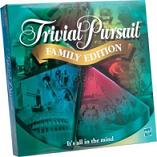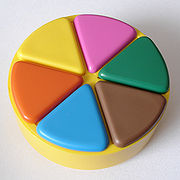Trivial Pursuit
 |
|
| Players | 2-6 (teams allowed) |
|---|---|
| Age range | 15+ |
| Setup time | 5 minutes |
| Playing time | ~30 minutes (varies widely) |
| Random chance | Medium (dice) |
| Skills required | General knowledge, Knowledge of Popular culture |
Trivial Pursuit is a board game in which progress is determined by a player's ability to answer general knowledge and popular culture questions. The game was created in 1979 by Canadian Scott Abbott, a sports editor for The Canadian Press, and Chris Haney, a photo editor for Montreal's The Gazette. After finding pieces of their Scrabble game missing, they decided to create their own game.[1] With the help of John Haney and Ed Werner, they completed development of the game, which was released in 1982.[2]
In North America, the game's popularity peaked in 1984, a year in which over 20 million games were sold. The rights to the game were licensed to Parker Brothers (now part of Hasbro) in 1988, after initially being turned down by the Virgin Group; in 2008, Hasbro bought out the rights in full, for US$80 million.[3] As of 2004[update], nearly 88 million games had been sold in 26 countries and 17 languages. Northern Plastics of Elroy, Wisconsin produced 30,000,000 games between 1983 and 1985. An online version of Trivial Pursuit was launched in September, 2003.[4]
Dozens of question sets have been released for the game. The question cards are organized into themes; for instance, in the standard Genus question set, questions in green deal with science and nature. Some question sets have been designed for younger players, and others for a specific time period or as promotional tie-ins (such as Star Wars, Saturday Night Live, and The Lord of the Rings movies).
Contents |
Gameplay

The object of the game is to move around the board by correctly answering trivia questions. Questions are split into six categories, with each one having its own color to identify itself; in the classic version of Trivial Pursuit, the Genus edition, these are Geography (blue), Entertainment (pink), History (yellow), Arts & Literature (brown), Science & Nature (green), and Sports & Leisure (orange). The game includes: a board, playing pieces, question cards, a box, and small plastic wedges to fit into the playing pieces.
Playing pieces used in Trivial Pursuit are round and divided into six sections. A small, plastic wedge can be placed into each of these sections to signify when a question from a certain category has been correctly answered.
During the game, players move their playing pieces around a track which is shaped like a wheel with six spokes. This track is divided into spaces of different colors, and the center of the board is a hexagonal shape. At the end of each spoke is a "category headquarters" space. When a player's counter lands on a square, the player answers a question according to the color of the square, which corresponds to one of the six categories. If the player answers the question correctly, their turn continues; if the player's piece was on one of the category headquarters spaces, they collect a wedge of the same color, which fits into their playing piece. Some spaces say "roll again," giving an extra roll of the die to the player. Any number of playing pieces may occupy the same space at the same time.
Questions are written on cards, with six questions on each card, one representing each category. The answers to the questions are on the back of the cards. These cards are stored inside a box/small box.
Once a player has collected one wedge of each color (to fill up their playing piece,) they make their way toward the hexagonal hub and answer a question in a category selected by the other players. If this question is answered correctly, then that player has won the game. Otherwise, the player must leave the center of the board and try again on their next turn.
Extra sets of cards with new questions can be purchased separately in order to enhance the game.
Editions
Over the years, numerous editions of Trivial Pursuit have been produced, usually specializing in various fields. The original version is known as the Genus edition (or Genus I). Several other general knowledge editions (such as Genus II) have followed.
Fred Worth lawsuit
In October 1984, Fred L. Worth, author of The Trivia Encyclopedia, Super Trivia, and Super Trivia II, filed a $300 million lawsuit against the distributors of Trivial Pursuit. He claimed that more than a quarter of the questions in the game's Genus Edition had been taken from his books, even to the point of reproducing typographical errors and deliberately placed misinformation. One of the questions in Trivial Pursuit was "What was Columbo's first name?" with the answer "Philip". That information had been fabricated to catch anyone who might try to violate his copyright.
The inventors of Trivial Pursuit acknowledged that Worth's books were among their sources, but argued that this was not improper and that facts are not protected by copyright. The district court judge agreed, ruling in favor of the Trivial Pursuit inventors. The decision was appealed, and in September 1987 the United States Court of Appeals for the Ninth Circuit in California upheld the ruling. The issue was taken to the Supreme Court of the United States, which rejected Worth's arguments in March 1988.
David Wall lawsuit
In 1994, David Wall of Cape Breton, Nova Scotia, launched a lawsuit against the game's creators. He claimed that in the fall of 1979, he and a friend were hitchhiking near Sydney, Nova Scotia, when they were picked up by Chris Haney. Wall claimed that he told Haney about his idea for the game in detail, including the shape of the markers.
Wall's mother testified she found drawings of his that looked like plans for a Trivial Pursuit-like game, but the drawings had since been destroyed. Wall's friend, who was allegedly hitchhiking with him that day, never testified. Haney said he never met Wall.
Over the years, there was much legal wrangling, notably around whether the suit should be decided by a judge or jury. On June 25, 2007, the Nova Scotia Supreme Court ruled against Wall.[5]
Dumbing down accusations
In the United Kingdom, Trivial Pursuit players have complained that recent versions of the game are dumbed down in comparison to previous editions, with easier questions and more focus on celebrities and show business.[6]
In popular culture
A version of Trivial Pursuit hosted by Wink Martindale aired on The Family Channel in the United States from 1993 to 1995. A syndicated version entitled Trivial Pursuit: America Plays aired from 2008 to 2009. It was hosted by Christopher Knight, though Mark L. Walberg hosted an unaired pilot.[7][8]
BBC Television produced a Trivial Pursuit game show based on the game in the UK hosted by Rory McGrath. Another British version (with rules/format similar to the Wink Martindale version) was hosted on The Family Channel (now Challenge) by Tony Slattery. Birgit Lechtermann hosted a version for VOX in Germany from 1993 to 1994.
In 1988, a made-for-television movie entitled Breaking all the Rules: The Creation of Trivial Pursuit was aired. Treated largely as a comedy, the movie featured the music of Ginette McLeod and portrayed the creators of the game as three beer-loving Canadians.
In September 2004, Roger Lodge hosted a sports trivia game show on ESPN based on Trivial Pursuit. Called ESPN Trivial Pursuit, it lasted five episodes.
In Spain, a version of the show called Trivial Pursuit: Spain Plays premiered in September 2008 on Antena 3.[9]
In an episode of Seinfeld, George Constanza gets into a physical altercation with a Bubble Boy over the answer to a Trivial Pursuit question.
References
- ↑ The History of Trivial Pursuit
- ↑ Trivial Pursuit History
- ↑ Trivial Pursuit sells for a non-trivial sum: $80 million US
- ↑ Trivial Pursuit Launches Online Version
- ↑ Hitchhiker loses Trivial Pursuit rights battle - ABC News (Australian Broadcasting Corporation)
- ↑ Trivial 'brain-teasers' enrage game's fans
- ↑ Debmar-Mercury Developing Trivial Pursuit TV Show - 10/23/2007 3:34:00 PM - Broadcasting & Cable
- ↑ tpamericaplays.com Trivial Pursuit: America Plays website
- ↑ C21Media:
External links
- Official site
- Exhaustive list of editions
- Trivial Pursuit rules
- Trivial Pursuit at BoardGameGeek
- Inventors and history
Multimedia
- CBC Archives CBC Television on the invention of Trivial Pursuit (1979)